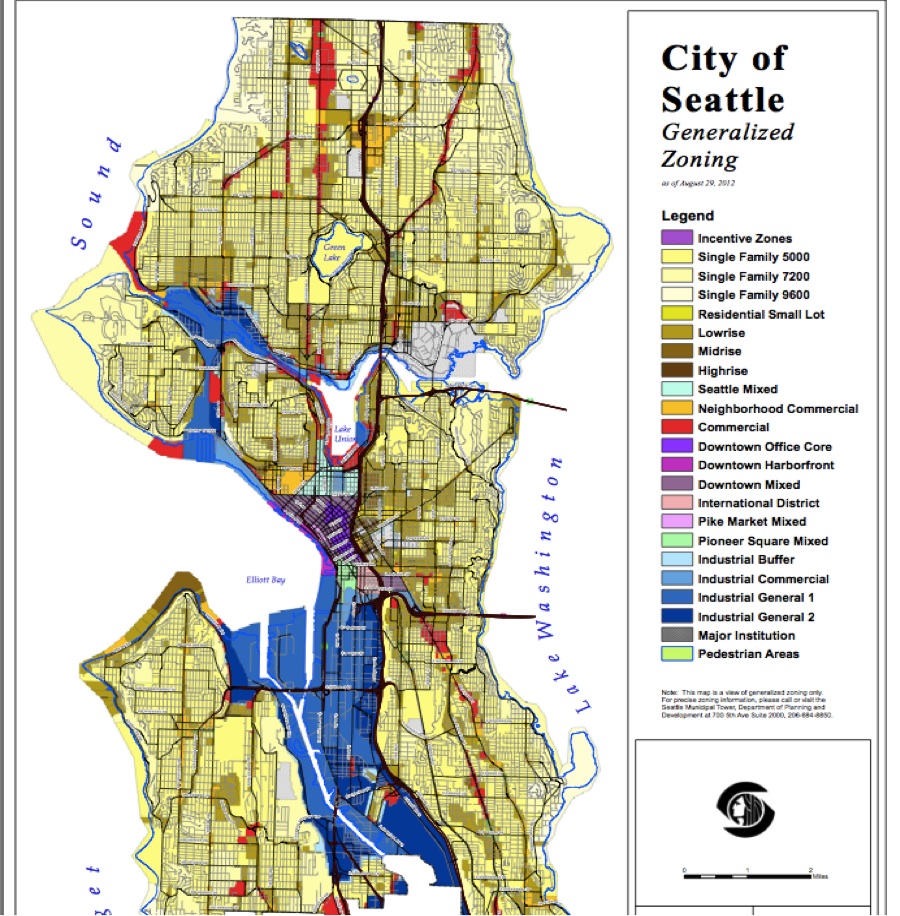Seattle as Open City: Upzone Single-Family, End Exclusionary Zoning
Part two of a post by David Moser. David Moser works on housing for Neighborhood House, a local non-profit. This post is a draft of an in-process working paper and was selected as a finalist in Seattle University’s Policy Incubator Competition, part of it’s Master of Public Administration program.
Exclusionary Zoning in Seattle
There are obviously many possible factors that can make it difficult for a city to build enough housing supply to meet demand. Sometimes the demand is so elevated that even in the face of increased housing supply, that increased supply is still not sufficient to strike a balance, and rents keep rising. That is what is happening is Seattle now. Another reason supply can have a hard time increasing sufficiently is the raw material to produce the product is unavailable. And sometimes there isn’t enough available labor. Thankfully, none of these constraints is currently impacting us in Seattle.
It might appear that land the greatest constraint to increased supply in Seattle is available land on which to build. We are surrounded by water afterall. Cities built on flat open plains with no natural or government-imposed growth boundaries (Phoenix, Atlanta, Houston, etc) can in fact more easily increase their housing supply by expanding outward horizontally and those cities have indeed seen much less dramatic increase in housing costs than the growing coastal cities (Yglesias, 2012).
But outward is of course not the only way a city can grow. We can build in and up. Major engineering achievements like the elevator and steel-frame construction make compact housing patterns quite easy to build, from a technological standpoint. We can build apartment buildings. So scarcity of land is not the primary constraint in limiting the supply of housing.
Take a look at the Generalized Zoning Map of Seattle.
What this analysis focuses on is the residential “Single Family” zones in various shades of yellow, and the residential “Lowrise”, “Midrise” and “Highrise” zones in various shades of brown. As we can see, the majority of the city is covered by some form of “Single Family” zoning, which means only detached, suburban style single-family homes can be built in those areas. “Multi-Family” apartment buildings are only allowed to be built in the Lowrise, Midrise, or Highrise Zones colored in brown. This shows clearly what is known as the “Urban Village” strategy adopted by the city in the 1980’s under mayor Norm Rice. The goal of this strategy was to channel all new growth into the Urban Villages like Capitol Hill, Ballard, Columbia City, University District, Alaska Junction, etc.
The crucial point is that all of those “Single Family” zones (all the various shades of yellow), is off-limits to any kind of apartment building. In all these areas, increasing the supply of housing by “building in and building up” is de-facto illegal. All of the growth is being channeled and compressed into the relatively tiny pockets where low, mid, and highrise building is allowed. What this amounts to is a government-imposed cap on the supply of housing on the majority of land in the city.
The Proposal and Its Politics
The City of Seattle should convert all land currently zoned as “Single Family” to “Lowrise Residential” (changing all the areas on the zoning map currently shaded yellow to brown). This would dramatically increase the number of possible areas in which dense, compact, multi-family housing could be built throughout the city of Seattle, and would over time allow the market to increase supply at a faster rate. This policy would require no increased revenue whatsoever. And fears that this change would instantly obliterate the quiet, suburban “character” of these zones are overblown. What it would mean is that over time, gradually, here and there apartment buildings would pop up in the 50% of the city in which they are now prohibited.
This is a radical, controversial proposal, especially since residents of Single Family zones are notoriously resistant to any such “upzoning”. “Not-in-my-backyard” sentiment is a strong political force in Seattle, and any public official proposing this change would have to be prepared for fierce backlash from “neighborhood activists”. But the fact is that when low-income people are being pushed from the city due to insufficient housing supply, any artificial caps on this supply are unjustifiable from a social justice perspective. Renters and construction unions would be sure to support this policy. This proposal is a compromise with those who would like no change at all to the Single-Family Zones. It is not proposing the complete elimination of restrictions on housing supply, as pure economics and social justice would recommend. It is coming half way. Let low-rise apartment buildings be built throughout Seattle.
Housing is a good thing, like jobs and clean air. Let it be built.
Works Cited
Balk, G. (2014, May 22). Census: Seattle Fastest Growing Big City in U.S. Seattle Times , retrieved from http://blogs.seattletimes.com/fyi-guy/2014/05/22/census-seattle-is-the-fastest-growing-big-city-in-the-u-s/.
Ehrenhalt, A. (2012). The Great Inversion and the Future of the American City. New York: Random House.
Florida, R. (2010). The Great Reset: How New Ways of Living and Working Drive Post-Crash Prosperity. New York: HarperCollins.
Frumkin, H., Frank, L., & Jackson, R. (2004). Urban Sprawl and Public Health. Washington D.C.: Island Press.
Glaeser, E. (2011). Triumph of the City: How Our Greatest Invention Makes Us Richer, Smarter, Greener, Healthier, and Happier. New York, New York: Penguin Books.
Goetz, E. G. (2013). New Deal Ruins: Race, Economic Justice, and Public Housing Policy. Ithaca: Cornell University Press.
Gordon, C. (2008). Mapping Decline: St. Louis and the Fate of the American City. Philadelphia: University of Pennsylvania Press.
Gyourko, E. L. (2008). Rethinking Federal Housing Policy. Washington D.C.: American Enterprise Institute.
Jackson, K. T. (1985). Crabgrass Frontier: The Suburbanization of the United States. New York: Oxford University Press.
Mangin, J. (2014). The New Exclusionary Zoning. Stanford Law and Policy Review , 25 (91), 91-120.
Owen, D. (2009). Green Metropolis: Why Living Smaller, Living Closer, and Driving Less are the Keys to Sustainability. New York, NY: Riverhead Books.
Pietila, A. (2010). Not in My Neighborhood: How Bigotry Shaped a Great American City. Chicago: Ivan R. Dee.
Rachel G. Bratt, M. E. (2006). A Right to Housing: Foundation for a New Social Agenda. Philadelphia: Temple University Press.
Ross, B. (2014). Dead End: Suburban Sprawl and the Rebirth of American Urbanism. New York: Oxford University Press.
Sampson, R. J. (2012). Great American City: Chicago and the Enduring Neighborhood Effect. Chicago: University of Chicago Press.
Wilkerson, I. (2010). The Warmth of Other Suns: The Epic Story of America’s Great Migration. New York: Vintage Books.
Yglesias, M. (2012). The Rent is Too Damn High: What to Do About It, and Why It Matters More Than You Think. New York: Simon & Schuster.



